| |
| |
 |

|
Trip to Turkey September 2004
|
 |
|
|
| |
| |
Sunday, September 19, 2004
We woke at sunrise, and dressed quickly so we would not be the last vehicle out of the gas station. Truck drivers park their trucks overnight at the gas stations. I did my best to stay hidden because there are very few women drivers in Turkey and certainly no women truckers. I just didn't know what kind of reaction to expect from truck driving Turkish men if they encountered a foreign woman in a place they didn't usually see women. Still we stood out: one lone small white dolmoosh surrounded by the largest trucks on Turkish roads. Gas stations almost all had restaurants and little convenience stores, but none of them carried road maps. Road maps were difficult anyway because none of the roads had identifying names or numbers, but it would have been nice to have a more detailed local map of an area, especially when trying to find particular ruins.
We had driven less than 200 feet when Tom saw the sign to Kanesh and Kultepe Karum. It was a little brown sign angled the wrong way in the middle of a construction zone. No wonder we had missed it. The two maps we had each showed it on a different side of the road. We pulled into a narrow potholed road (about normal for side roads in this area) and drove 100 feet.
Our guide book said that the site was open for tours Monday through Saturday, 8:30am to 6:30pm. Today was Sunday and it was 7:30 am. We parked in an empty gravel pull-out spot across from a large sign that said Kultepe and Karum Kanesh. There was a rocky dugout excavation on the right and a large mound behind a locked gate on the left. We climbed out of the dolmoosh and were deciding to explore on our own, when an old Turkish man approached us and asked if we were looking for Karum Kanesh. We said yes and he told us we could enter there. It didn't look like much of an entrance: no signs, no turnstiles, just one little chain link gate with no lock. As we walked closer to the ruins, the dug out stones in the ground, we could see that there was a crew excavating at the far end. Our guide knew very little English, but a little more English than we knew of Turkish. We did what we recognized as polite Turkish custom. We spoke to him in Turkish except when we didn't know the words we wanted and couldn't fake it, and he answered us in broken English, better than our broken Turkish.
|
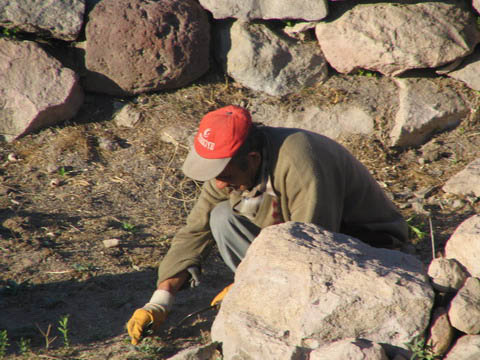
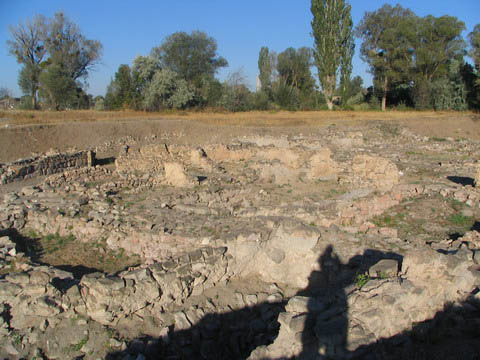
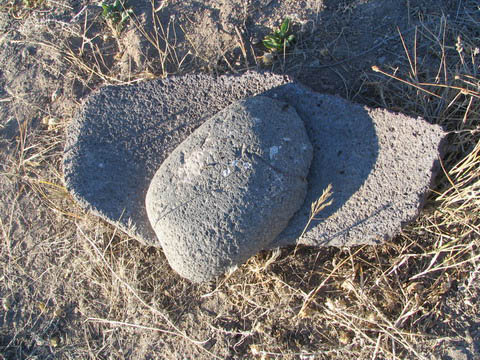
|
Mostly he pointed. He led us around one dug out area and then another, he pointed to the signs that were written in both Turkish and English. This was one of the few places where small objects lay where they had been found, mostly urns, ovens, and stones for grinding grain into flour. The thousands of clay tablets with writing had all been removed to the museum. The Karem was an Assyrian trading post which grew large enough to be a city. It grew around the Anatolian/Hattian city of Kultepe and later the Hittite city of Kanesh.
There were places at this ruin site where he requested that we refrain from photographing, so we asked to make sure that we were photographing only the acceptable sites. |
 |
 |
Although none of the signs mentioned it, this was the place that Hittites took the name of their language from. If you asked a Hittite person what language she spoke, she would say "Nessa" or "Kanesh" (Nessa being the shortened version of Kanesh), the language identified with Kanesh.
There are some interesting linguistic things in Turkish that make me wonder. It might be just a coincidence but the word for "sun" in Turkish is ganesh. Some of the "thousand" Hittite Gods were gods of the Rig Veda, including Varunna, and Agni. I'll stop before I'm accused of wild speculation.
After the tour of the Karum, which took about an hour because there was a lot to see and the old man took us at our pace, he asked for the equivalent of $4.00 and wouldn't accept more which we gratefully offered. Then, he took us across the street to see Kultepe, unlocking the gate, and spending another hour with us, again refusing to take more money, although he did accept the cookie Tom offered him.
|
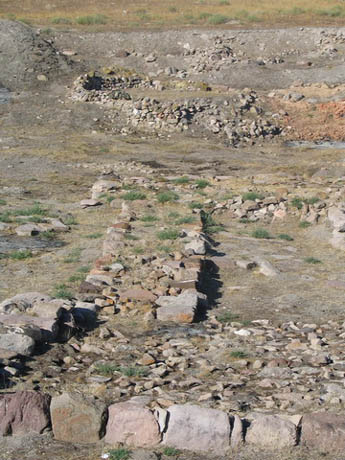 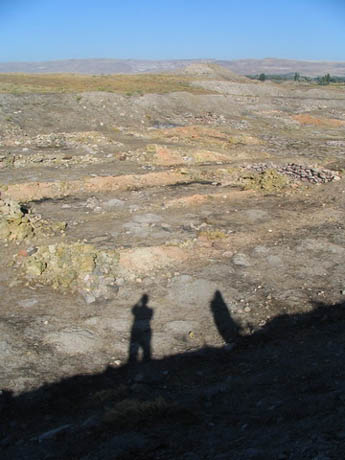
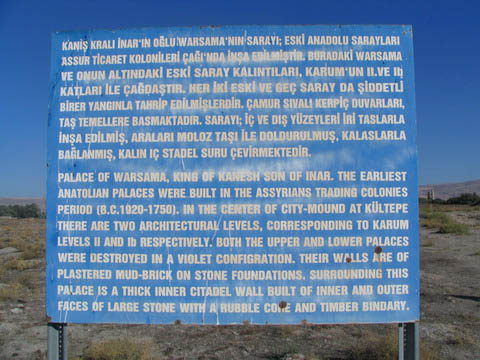
|
At 9:30am we left, on our way to breakfast. The whole time we were at this site, there were no other tourists. It is funny, because if you read about Kultepe in an archeological publication, they have lots to say about it.
With all this walking and not having had much of a dinner the previous night we were very hungry. So we went to a gas station to fill up our tank and get breakfast. While we were sitting outside at the restaurant attached to the gas station having breakfast, a gas station attendant insisted on washing the van and refused to take money for it.
After breakfast we were headed towards Yozgat for the ruins of Hattushush and Yazilikaya. By 10:30am we were in Himmeldede. By 1:15pm we were in Yozgat
|
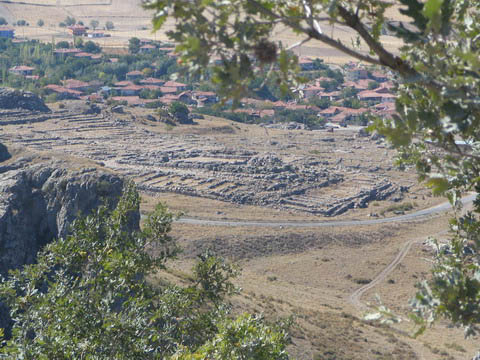
|
We arrived at Hattushush at 2:30 pm and looked at the large map posted at the entrance. I asked if there were small paper maps for visitors. No. But the man who greeted us at the gate claimed to be an archaeologist and was willing to give us a guided tour for a fee. We declined.
The ruins were accessible by car, although it would have been possible to hike through most of it in a full day or a day and a half. The terrain was rolling hills. We parked the car in the parking area outside the first stopping point and took a short hike to the entrance.
Tom took a single picture and discovered that he needed new batteries. I stood at the entrance and waited for him while he went back to the van. I waited for what seemed like a long time. My feet were twitching. Finally I couldn't hold myself back any longer and my feet carried the rest of me - as if drawn by some part other than my conscious mind, leaping over the large stones through the temple entrance through the courtyard to the Goddess rock on the opposite side.
I put my arms around the stone as far as they would go and pressed my forehead to it. I don't know if it was the stone, or the spot, or my own mind responding to some trigger, but whatever it was, happened instantly. The moment my head touched the stone I was filled with a feeling of encompassing warmth, an inner brightness, and a sensation that everything outside of the rock and myself was gently spinning around it. These feelings were accompanied by collections of impressions as if a compressed file was downloading in a flash. I knew that this was the same kind of thing I had experienced at age 4. It somehow felt as if it was from the same source. This is why I had been drawn to Anatolia, but I was surprised with the ease in which it "just happened."
|
 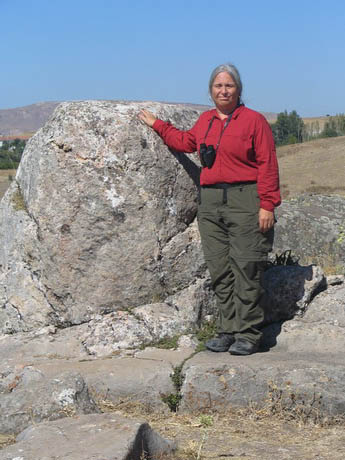
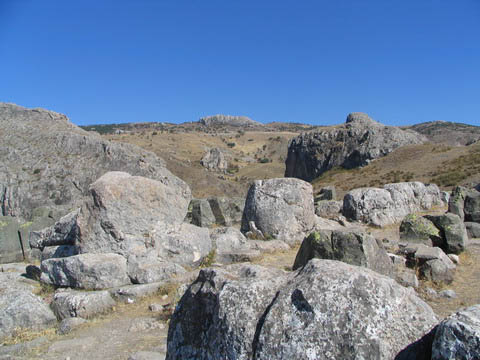
|
Meantime, Tom was catching up to me, as were the hawkers, carrying their wares to sell to any lingering tourist, a most unwelcome interruption. Fortunately, Tom firmly drove them away from me. Had he not done that I might have gone berserk and tried to scratch their eyes out. I was in that kind of state, and I'm sure it would have had miserable consequences.
Before we walked away from the altar stones, Tom asked "Nothing for Dad?". I'm grateful to him for that because in my joy of reuniting with a place of power of feminine source, I had nearly forgotten; after all, the sounds of call-to-prayer were all around us, it was not like the masculine side of the divine had ever been neglected here. I embraced the altar pedestal of the God and felt another rush of warmth, almost as strong, no downloading this time, though.
We spent over an hour exploring all around the temple site. I told Tom "let's pretend I have past life memories and I'll describe the functions and design of each of these spaces." And we did just that. We passed from stone to stone and I let images flood into my head and I described what I saw. I have no idea how accurate I was, but I think it is probable that some of it might be more accurate than what is known about Hattushush today.
|
After the temple, there was not much else on my "must see" list of Hattushush, but the back gate, the lion's gate was one. We arrived at the lion's gate at about 4:00pm. Here I had a reaction I didn't expect. The gate and the walkway up to the gate were from a repetitive vision I had from about age 22 on. A few of the things had changed. There was the upwardly inclined walkway that paralleled the wall. The wall was to the right of the walk way as you approached the gate. On the left was a drop into a valley. I remembered that drop as being tree-lined with a stream behind it but I didn't see either the trees or the stream there now.
The sign said that the gate door was wooden and had not lasted through time, but I remembered the door as being shiny gold: at sunset it could be seen for many miles. There is, of course, a chance that the wooden door might have been covered with gold plating and that the plating was one of the first things looted.
|  |
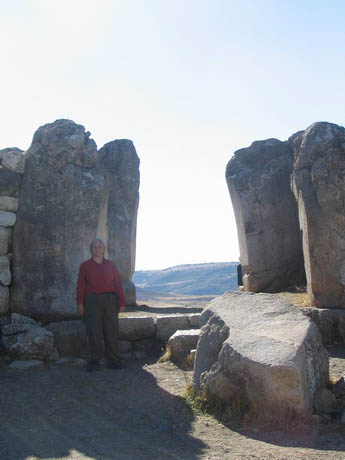 |
The Turks who work at Hattushush understand that this area is an attraction to foreign tourists, and an antiquity, but they have no sense of this as anything that might have any emotional significance to anyone beyond mere history or curiosity. They do not regard it as anyone's shrine. It might be better that they remain clueless. The ruins might be safer this way.
We entered the outdoor shrine of Yazilikaya at 5:00pm. Yazilikaya was not as I expected and I did not feel as much of a connection here as I did at Hattushush. Tom suggested that if I really did have "past life" memories, maybe they predated Yazilikaya. I expected an open area with carvings on cliffs. What I saw instead was outcroppings with narrow passages. This was not, as I first extrapolated, a gathering area. It wasn't large enough. Instead, it was probably a teaching area, maybe of the inner mysteries.
|

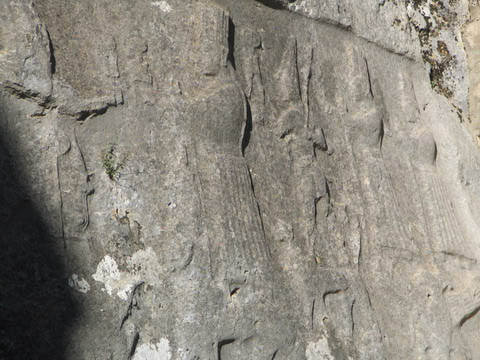
|
 |  |
I poured a libation of seawater and left an offering of red berries at Yazilikaya. The carvings are wearing away so that some important details are being lost. I hope they can do some restoration work on it before we lose too much more. None of the Goddesses (or priestesses carved impersonating Goddesses) had any head covering except in the case of a crown. Many of the Goddesses had long hair hanging down their backs but it is unclear if that hair is bound into a braid or completely unbound. The detail has been lost. After my visit to Yazilikaya, I no longer wore any covering on my head.
|
Before we exited from Yazilikaya, Tom led me to where he heard running water. There was a fountain and I dipped my hands into the running water and anointed my forehead, eyes, ears, mouth, heart.... Just as I finished, the water stopped running in the fountain, leaving Tom and I to puzzle over whether or not there was a shut-off valve somewhere.
After Yazilikaya, I returned to the entrance area and to the souvenir booths where there were little carved stone replicas of Yazilikaya. I purchased several. The vendors came yelling after me "Lady, lady" trying to get me to buy more as I rushed into the dolmoosh for an escape.
|  |
 |
We spent the night at the Kale Hotel and Camping. It had a grand porch with tables and chairs. We sat there watching the sunset over the hills with the Hattushush city walls skimming the horizon for about 120 degrees. Surely this structure was built on the same spot where something else must have been thousands of years ago.
The hotel also had nicer stone carvings, for sale at better prices than the souvenir stands at Hattushush. It also had western toilets in bad repair, but that was better than what we had seen on the road for days.
|
|
|
| |
|
|
| |
| |
Created: November 15, 2004
Updated: November 21, 2004
|  
|
|
|
| |
|
|